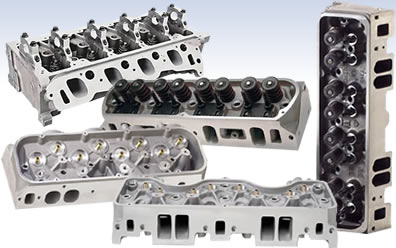We recently reached out to the guys in Summit Racing’s renowned tech department—the largest full-time staff in the industry—to identify and answer five common tech questions they hear on a consistent basis. With help from Summit Racing’s tech advisors and other industry experts, we’ll answer those questions here at OnAllCylinders. Today’s topic: cylinder heads.
Few components have a bigger effect on performance than your cylinder heads.
In conjunction with your fuel system and intake manifold, cylinder heads control the amount of air and fuel that’s fed to your engine. Along with your rotating assembly, they play a huge part in determining compression, and your heads work with your camshaft and valvetrain to create your engine’s power and torque curve.
It’s no wonder so many Summit Racing customers ask: When do I need to make the jump to aftermarket cylinder heads? According to Norm Koval, a team leader in Summit Racing’s technical department, it’s one of the most common questions his team members hear.
“As a rule of thumb, we use that horse-per-cube (or greater) threshold as the point where you might consider a specialty cylinder head,” Koval said. “Mass production factory heads don’t have a great deal of uniformity in design and they’re not designed to flow and accommodate drastically larger power numbers. And very few factory heads are able to handle stroker or large cube, large displacement upgrades.”
Koval is quick to point out that you may be able to cross that “horse-per-cube” level with factory heads—but it may end up costing you in the long run.
“Are there exceptions? Certainly,” Koval said. “But to get the factory head where it needs to be, you may be talking about a valve job, bowl blend, hardened seats, or other modifications. You could wind up spending four or five hundred bucks or more on the factory head anyway.”
Factors in Choosing the Right Cylinder Head
If you decide to upgrade to aftermarket cylinder heads, you should have some basic information available to ease the shopping process. To help focus in on the right cylinder head for you application, Koval typically asks customers for the following information:
- Engine cubic inch
- Desired compression ratio
- Intended rpm range and/or vehcle application (street, race, etc.)
- Camshaft profile
- Current and future modifications
- Budget
“Budget always comes into play,” Koval said. “If we’re talking about assembled heads, we also have to look at matching the valve springs to the cam profile and valve size to the engine size. If we’re looking at bare castings, we can worry about these factors later.”
Cast Iron vs. Aluminum Cylinder Heads
Cylinder heads come in two main flavors: cast iron and aluminum. Choose cast iron heads for:
- Excellent durability
- Lower price compared to many aluminum heads
- Low to moderate compression
- Heat retention
Choose aluminum heads for:
- Lightweight design—great for drag racing or other competition
- Superior heat dissipation over cast iron
- Moderate to high compression ratios (more resistant to detonation)
People tend to choose aluminum heads for racing applications because of thier light weight and ability to dissipate heat,” Koval said. “But all things being equal, cast iron heads almost always produce more power than comparable aluminum heads.”
Basic Cylinder Head Design—Bigger is Not Always Better
In addition to construction—cast iron or aluminum—key factors in cylinder head design include intake and exhaust runner volume, size, and shape; combustion chamber size and shape; and valve size. These are the key factors that determine airflow volume and rate, engine compression, and combustion level.
When it comes to intake runners, remember this rule of thumb: “Bigger is not always better.” For example, a larger intake runner will allow a great volume of airflow, but the larger “tunnel” will also slow the velocity of gasses flowing into the cylinder head. This will adversely affect throttle response and low-rpm power. Typically, the larger the intake runners, the higher the powerband—and massive intake runners may generate high-rpm power gains that are not ideal for the street.
The key is striking the right balance between airflow volume and velocity to make power gains where your vehicle can really use it. Check out this video on cylinder head runners for more information on how runner size and shape affect performance.
Size matters when it comes to combustion chambers, too. For example, a larger combustion chamber will increase the area over the piston at top-dead-center, thereby reducing compression ratio. This video on combustion chambers explains how combustion chamber size and shape affect compression ratio, airflow, and overall performance.
Finally, valve size will have a direct effect on airflow. While a larger intake valve will allow more air to flow into the engine (other factors such as valve lift also play a role), there are limitations to the size of the valve you can use. For example, a Chevrolet 283 or 305 engine can’t accommodate a common 2.02-inch small block valve because of their small bore sizes. As this video on cylinder head valve size will tell you, the edges for cylinder walls would have to be clearanced.
As with any engine modification, always be reasonable with your performance expectations (consider your torque converter stall and gear ratio) and remember the ultimate intended purpose of your vehicle.


What’s burp & how
The RIGHT info (Not everyone adheres to)